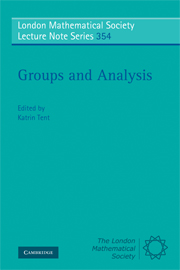Book contents
- Frontmatter
- Contents
- Preface
- List of speakers and talks
- 1 Harmonic analysis on compact symmetric spaces
- 2 Weyl, eigenfunction expansions, symmetric spaces
- 3 Weyl's work on singular Sturm–Liouville operators
- 4 From Weyl quantization to modern algebraic index theory
- 5 Sharp spectral inequalities for the Heisenberg Laplacian
- 6 Equidistribution for quadratic differentials
- 7 Weyl's law in the theory of automorphic forms
- 8 Weyl's Lemma, one of many
- 9 Analysis on foliated spaces and arithmetic geometry
- 10 Reciprocity algebras and branching
- 11 Character formulae from Hermann Weyl to the present
- 12 The Classification of affine buildings
- 13 Emmy Noether and Hermann Weyl
10 - Reciprocity algebras and branching
Published online by Cambridge University Press: 12 May 2010
- Frontmatter
- Contents
- Preface
- List of speakers and talks
- 1 Harmonic analysis on compact symmetric spaces
- 2 Weyl, eigenfunction expansions, symmetric spaces
- 3 Weyl's work on singular Sturm–Liouville operators
- 4 From Weyl quantization to modern algebraic index theory
- 5 Sharp spectral inequalities for the Heisenberg Laplacian
- 6 Equidistribution for quadratic differentials
- 7 Weyl's law in the theory of automorphic forms
- 8 Weyl's Lemma, one of many
- 9 Analysis on foliated spaces and arithmetic geometry
- 10 Reciprocity algebras and branching
- 11 Character formulae from Hermann Weyl to the present
- 12 The Classification of affine buildings
- 13 Emmy Noether and Hermann Weyl
Summary
ABSTRACT We study branching laws for a classical group G and a symmetric subgroup H. Our approach is by introducing the branching algebra, the algebra of covariants for H in the regular functions on the natural torus bundle over the flag manifold for G. We give concrete descriptions of certain subalgebras of the branching algebra using classical invariant theory. In this context, it turns out that the ten classes of classical symmetric pairs (G, H) are associated in pairs, (G, H) and (H′, G′).
Our results may be regarded as a further development of classical invariant theory as described by Weyl [64], and extended previously in [14]. They show that the framework of classical invariant theory is flexible enough to encompass a wide variety of calculations that have been carried out by other methods over a period of several decades. This framework is capable of further development, and in some ways can provide a more precise picture than has been developed in previous work.
Introduction
The Classical Groups.
Hermann Weyl's book, The Classical Groups [64], has influenced many researchers in invariant theory and related fields in the decades since it was written. Written as an updating of “classical” invariant theory, it has itself acquired the patina of a classic. The books [11] and [55] and the references in them give an idea of the extent of the influence. The current authors freely confess to being among those on whom Weyl has had major impact.
- Type
- Chapter
- Information
- Groups and AnalysisThe Legacy of Hermann Weyl, pp. 191 - 231Publisher: Cambridge University PressPrint publication year: 2008
- 6
- Cited by

